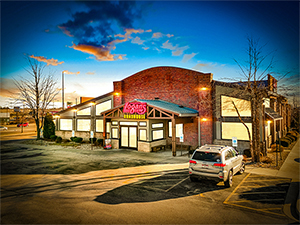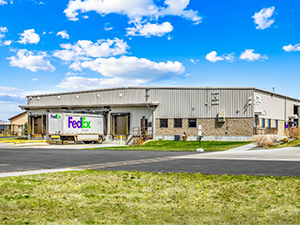The Pros and Cons of a Ground Lease For Sale
Net lease real estate is attractive for conservative investors who are looking for long-term profits and benefits from their investment in a property. In addition to net lease opportunities on existing structures, there is another revenue stream you can explore for your portfolio-ground leases.
As you are considering investing in a ground lease (also known as a land lease) for sale, you must understand the benefits and responsibilities you will have as the landowner. While a ground lease can be advantageous over a long-term period for property owners, there are some key details to understand before adding a ground lease to your portfolio.
What is a Ground Lease?
As the name suggests, a ground lease only includes leasing the ground, not buildings. A ground lease encompasses undeveloped commercial land that is leased to tenants. Then, tenants have the privilege to develop and use the property during the lease’s duration. Thus, a ground lease is an agreement between a landowner and a tenant, in which the tenant leases land for a new build. The lessee only owns the building and is responsible for all the expenses and costs associated with constructing and maintaining a business location on a leased piece of land. The landowner, however, is typically still responsible for the annual property taxes on the land itself.
NNN ground leases are usually extremely long-term (20 to 40 years is common for an initial term, but they can last anywhere 50 to 99 years), but if the tenant ever defaults or the term of the lease expires, then the landowner will take over ownership of the building on their land as well. Improvements made to land with a ground lease reverts to the landlord after the lease expires, or the tenant could be required to demolish them.
An Example of a Ground Lease
During a ground lease’s term, the tenant owns the improvements made on the property, such as the buildings it constructs. For example, many Macy’s department stores have ground leases. As a result, Macy’s owns the buildings and any other upgrades, such as parking structures. However, the company pays rent on the land below each store.
Another company that utilizes ground leases is American Tower, which owns and operates communications towers that power mobile phone networks. The company usually leases land throughout the country to build the towers.
American Tower has signed ground leases on about 70% of its U.S. towers. As a result, the company works with 35,000 different property owners. There are about 28 years left on most of its ground leases, but instead of allowing the leases to expire, the company typically extends the lease or buys the land to end the ground lease.
The business model works for the company (and its landlords) for several reasons. First, American Tower can grow its network of towers without a large expenditure of capital that would be necessary to buy land to erect thousands of towers. There are also tax advantages, as the eventual lease buyouts gradually convert operating expenses to capital expenditures, and, in turn, have a few advantages for ongoing tax purposes. From the landlord’s point of view, they can earn decades of rental income and eventually (in many cases) receive a lump-sum payment for the property.
Similar to other real estate leases, ground leases oblige tenants to pay monthly rent. Ground leases are commonly net leases, which require tenants to cover property taxes, insurance, and maintenance expenses during the lease’s term.
Subordinated Ground Lease vs. Unsubordinated Ground Lease
There are typically two types of ground leases: subordinated vs. unsubordinated.
In a subordinated ground lease, a tenant can finance improvements for the property by taking on separate debt that is leveraged with the ground serving as collateral on improvement-based net lease financing. Since there is more risk involved for the property owner, they may charge higher rent payments in this type of lease to account for that added risk of financial responsibility should the tenant default on their loan.
In an unsubordinated ground lease, the landowner retains top priority on claims to the land in the event of default, which means that a lender can’t take over the land if a tenant defaults. Unsubordinated leases are less common, as lenders are more hesitant to offer funds without collateral.
In most cases, landlords generally have to charge lower rent on unsubordinated ground leases to encourage tenants to sign the agreement. The majority of lenders won’t originate loans to build commercial buildings on ground leases unless they are able to foreclose the property if a tenant defaults.
Unsubordinated ground leases are the more common arrangement, even though they usually produce less rental income for the landlord. That is because landlords prefer to have an active stake in the tenant’s business and avoid placing their properties at risk.
Advantages of a Ground Lease
Ground leases can be advantageous for both the landowner and the lessee. Here’s a closer look at the benefits of a NNN ground lease, from the perspective of the property owner:
- Stable Income Stream
- Low-Risk Investment
- Low-Touch Management
In numerous cases, land lease deals are conducted with a parcel that is in a sought-after location and has distinctive attributes that cannot be copied. As a result, the ground lease allows the landowner to profit from the property they are leasing to the lessee (often developers) without putting it up for sale or making significant improvements to develop the site on their own. Thus, they can create a long-term source of income from a vacant property. If the landowner owns parcels of land nearby, they may also profit as the value of those properties climb in value thanks to the construction on the main property.
Major corporations such as McDonald’s like to build new restaurants by making use of ground leases. The corporation usually buys the land and leases it to the local franchise to construct the building, establish the operation, and run the business. McDonald’s likes ground leases because the land can only be appropriated to develop a McDonald’s restaurant. The developer is obligated to follow the terms of the lease agreement and cannot decide to change his franchise to a Burger King a few years after signing the agreement.
Most NNN ground lease agreements also include a Reversionary Clause. That clause stipulates that if a tenant defaults on their lease or the term of their lease ends, ownership of the building then reverts to the landowner as well (and usually at no significant cost to the landowner). This clause protects your investment and allows you to continue profiting from the land lease agreement and the building in the future should the lease go into default or end.
Advantages for the Tenant
A ground lease allows a developer to utilize or monetize a parcel of land that may be cost-prohibitive to purchase. For example, in a number of instances government properties are too costly for an investor to acquire but renting a government property is much more doable.
Tenants benefit in a NNN ground lease because they can often find a desirable location for their business that would not otherwise be available to them without having to fund a property purchase themselves. Ground lease tenants may also obtain some tax benefits, such as deducting their land rental payments against their business income.
Drawbacks of a Ground Lease
While NNN ground leases can be greatly beneficial for investors, there is an important tax consideration to make when determining if this type of lease and investment is the right one for you.
As a landowner in a NNN ground lease, you will typically be responsible for the annual taxes on the land itself. Taxes on land alone do not depreciate over time. Since the land and building are under separate ownership in this type of commercial real estate lease, it means that the investor (and landowner) will not be able to receive tax benefits over time since land does not depreciate.
The Difference Between a Ground Lease and a Leasehold
The term “leasehold” is often used interchangeably with the term “ground lease.” The use of Leaseholds in residential real estate is less commonplace in the U.S., except in certain states or metropolitan areas, including Hawaii, the Baltimore metro area, and several cities in Florida. They are generally used more in commercial real estate.
However, the leasehold and ground lease can have different nuances, depending on the region of the country and the term’s usage. A ground lease empowers lessees to develop the property as they see fit and they own the buildings built on the property during the ground lease’s entire term. In contrast, with a leasehold, the lessee may have to comply with many more restrictions concerning developments that can or cannot be built on a property.
In some locations, however, the two terms are more similar. For example, leaseholds for residential properties in Maryland are referred to as “ground rent,” and these properties are monitored through an online registry maintained by the Maryland Department of Assessments and Taxation. If no one knows who the rightful owner is, lessees in Maryland may retain ground rent payments in escrow for up to three years to provide time for the landowner to come forward and prove his or her ownership of the property.
Under leasehold ownership, the lessee has the exclusive use and proprietorship of a property for a specified period. The leaseholder buys the building and structures according to the specified period but does not own the land under the building. The owner of leasehold property pays the agreed-upon rent in full to the owner of the land or dirt. The lessee can improve the building or other structures, but when the lease ends, ownership of the premises returns to the owner. Because the lessee owns the structures that were built on the parcel of land, he or she can take advantage of real estate tax depreciation.
Also, the lease rents may be adjusted, typically every 10 to 15 years. The amount of the new, adjusted rent is contingent on the current land market value. If the land value rises over time, then the rent will probably increase as well.
What Happens at the End of a Ground Lease?
During the ground lease term, the tenant usually owns and depreciates the improvements. When the lease ends, the ground lease typically stipulates that the property owner is the owner of all improvements and additions built by the tenant. These types of provisos will guarantee that the property owner is the owner not only of the underlying land but also the improvements made by the tenant. The landlord does run the risk of inheriting potential environmental liabilities from the tenant’s construction.
The landlord in a ground lease may also be eligible for a termination fee if the tenant decides to end the lease before the contract’s closing date. The tenant may want to voluntarily end the lease early for several factors, including a downturn in the real estate market or a recession that makes it unprofitable for him or her to build improvements on the land.
Sands Investment Group (SIG) has expertise in the commercial net lease industry, spanning all types of NNN properties, and we offer NNN ground leases for sale as part of our $1 billion in inventory. Our client-focused approach, extensive connections, ground lease valuation, and marketing expertise are just a few of the reasons we’re the fastest-growing net lease investment company in America, with 3,300 closed transactions worth $6.5 billion since 2010.
Get in touch with a NNN ground lease expert today by calling 844.4.SIG.NNN or sending us an email at info@SIGnnn.com.
By submitting your information and signing up for email updates, you agree to SIG Online Terms of Use


